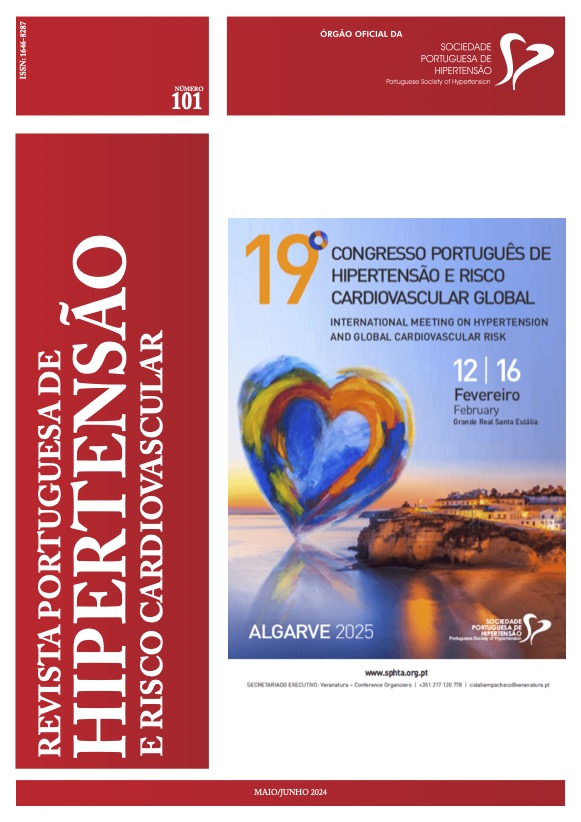ANALYSIS OF 16528 INDIVIDUAL 24-HOUR AMBULATORY BLOOD PRESSURE MONITORING RECORDS REFERRED TO A HYPERTENSION UNIT FOR 23 YEARS
DOI:
https://doi.org/10.58043/rphrc.131Keywords:
Twenty-four-hour ambulatory blood pressure (ABPM), level of control of hypertension in office and in ABPM, antihypertension medicationAbstract
Twenty-four hour ambulatory blood pressure (ABPM) is an essential tool in the evaluation of hypertensive patients. The present study consisted of the retrospective evaluation of 16528 ABPM records made at the Hypertension and Cardiovascular Risk Unit of ULS Matosinhos between January 2000 and December 2022 in patients with arterial hypertension, under medication and without previous cardiovascular events. This population (51% women, aged 18-80 years) was divided into 5 groups according to the total number of antihypertensive drugs prescribed, i.e. 1, 2, 3, 4 or >=5. About 29% of patients were on monotherapy. The in-office blood pressure (BP)-based hypertension control rate (<140/90 mm Hg) was lower than the hypertension control rate based on ABPM (24 hours < 130/80 mm Hg), which suggests the presence of a white coat effect detected in ABPM. The increasing number of antihypertensive drugs prescribed was associated with indicators of greater severity of the hypertensive situation, translated by higher values of age (54+16 to 63+13 years), BMI (27.3+4.0 to 29.7+4.8 Kg/m2), casual BP (148/89+20/13 to 160/88+25/16 mmHg), 24-hour BP (128/75+13/9 to 137/75+18/12 mmHg), and aortic stiffness index (0.37+0.18 to 0.46+0.19), and a lower decrease in nocturnal systolic BP (11.9+7.7 for 8.4+9.2 %) all p<0.01, as well as to more frequent use of diuretics, angiotensin receptor antagonists, beta-blockers and calcium antagonists. The study confirms the advantage of ABPM in the stratification of cardiovascular risk, in the evaluation of real blood pressure control and in the diagnosis of the white coat phenomenon in medicated hypertensive patients.Downloads
References
Pickering TG, Coats A, Mallion JM, Mancia G, Verdecchia P. Blood Pressure Monitoring. Task force V: White-coat hypertension. Blood Press Monit. 1999;4(6):333-41.
Staessen JA, Beilin L, Parati G, Waeber B, White W. Task force IV: Clinical use of ambulatory blood pressure monitoring. Participants of the 1999 Consensus Conference on Ambulatory Blood Pressure Monitoring. Blood Press Monit. 1999;4(6):319-31.
Pickering TG. Utility of 24 h ambulatory blood pressure monitoring in clinical practice. Can J Cardiol. 1995;11 Suppl H:43H-8H.
VerdecchiaP,SchillaciG,BorgioniC,CiucciA,PorcellatiC. Prognostic significance of the white coat effect. Hypertension. 1997;29(6):1218-24.
Chobanian AV, Bakris GL, Black HR, Cushman WC, Green LA, Izzo JL, Jr., et al. The Seventh Report of the Joint National Committee on Prevention, Detection, Evaluation, and Treatment of High Blood Pressure: the JNC 7 report. JAMA. 2003;289(19):2560-72.
Mancia G, Kreutz R, Brunstrom M, Burnier M, Grassi G, Januszewicz A, et al. 2023 ESH Guidelines for the management of arterial hypertension The Task Force for the management of arterial hypertension of the European Society of Hypertension: Endorsed by the International Society of Hypertension (ISH) and the European Renal Association (ERA). J Hypertens. 2023;41(12):1874-2071.
Bastos JM, Bertoquini S, Silva JA, Polonia J. Relationship between ambulatory blood pressure monitoring values and future occurrence of ischemic cerebrovascular and coronary events in hypertensive patients. Rev Port Cardiol. 2006;25(3):305-16.
Polonia JJ, Gama GM, Silva JA, Amaral C, Martins LR, Bertoquini SE. Sequential follow-up clinic and ambulatory blood pressure evaluation in a low risk population of white-coat hypertensive patients and in normotensives. Blood Press Monit. 2005;10(2):57-64.
Bastos JM, Bertoquini S, Polonia J. Prognostic significance of ambulatory arterial stiffness index in hypertensives followed for 8.2 years: its relation with new events and cardiovascular risk estimation. Rev Port Cardiol. 2010;29(9):1287-303.
Boos CJ, Hein A, Khattab A. Ambulatory arterial stiffness index, mortality, and adverse cardiovascular outcomes; Systematic review and meta-analysis. J Clin Hypertens (Greenwich). 2024;26(2):89-101.
Downloads
Published
How to Cite
Issue
Section
License
Copyright (c) 2024 Isabel Azevedo, Loide Barbosa, José Alberto Silva, Jorge Polónia

This work is licensed under a Creative Commons Attribution 4.0 International License.




